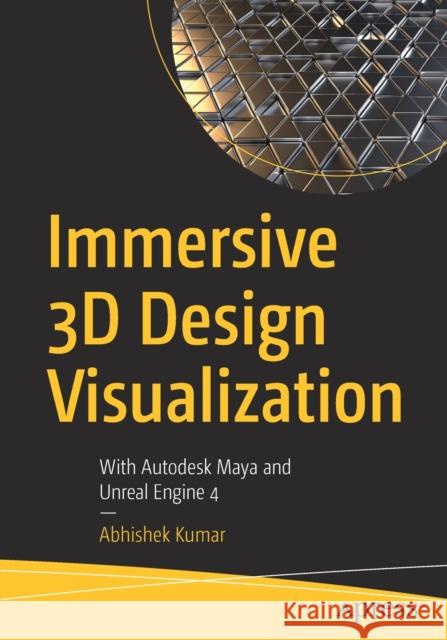Immersive 3D Design Visualization: With Autodesk Maya and Unreal Engine 4 » książka



Immersive 3D Design Visualization: With Autodesk Maya and Unreal Engine 4
ISBN-13: 9781484265963 / Angielski / Miękka / 2020 / 301 str.
Immersive 3D Design Visualization: With Autodesk Maya and Unreal Engine 4
ISBN-13: 9781484265963 / Angielski / Miękka / 2020 / 301 str.
(netto: 230,54 VAT: 5%)
Najniższa cena z 30 dni: 231,29 zł
ok. 22 dni roboczych
Bez gwarancji dostawy przed świętami
Darmowa dostawa!
Beginner to Intermediate level
Chapter 1: Design for Creative and Immersive Technology
• Scope of this book
• Topics covered
• Design visualization
• Emerging technologies (VR, AR, and MR)
Chapter 2: Tools for Architectural Visualization
• MAYA for design visualization
• Substance for PBR texturing
• Design visualization gamification (UE4)
Chapter 3: 3D Design with Autodesk Maya
• Basics of modelling
• Basics of unwrapping
• Basics of Substance Painter
Chapter 4: Interactive Visualization with UE4
• Interface of UE4
• Exploring tools
Chapter 5: Creating Virtual Worlds
• Modelling assets
Chapter 6: Unwrapping our Assets
• Introduction to unwrapping
• Unwrapping assets
Chapter 7: Lightmap Analysis and Correction
• Creating Lightmap UVs
• Static vs. dynamic lighting
• Lightmap analysis, correction, and padding
• Shader analysis and tweaking
Chapter 8: PBR Integrated Texturing
• Importing and baking maps
• Texturing various assets
Chapter 9: Material Design and Integration
• Exporting for UE4
• Importing into UE4
• Material setup
Chapter 10: Real-Time/Emissive Materials
• Emissive workflow in Substance Painter
• Emissive workflow in UE4
Chapter 11: Interaction Design in VR Engine
• Importing 3D assets
• Object properties editor
Chapter 12: Unreal® Engine 4 for Level design
• Creating level
• Documenting problems and errors
Chapter 13: Design Visualization Capstone Project: Testing and Fixing Errors
• Fixing errors
Chapter 14: Design Visualization Capstone Project: Aesthetic Development
• Completing level design
• Lighting our scene
Chapter 15: Immersive Design Portfolio
• Cleaning up
• Testing with VR headsets
• Thoughts and suggestions
Dr. Abhishek Kumar is an assistant professor in the Department of Computer Science at the Institute of Science at Banaras Hindu University. He is an Apple Certified Associate, Adobe Education Trainer, and certified by Autodesk. He is actively involved in course development in animation and design engineering courses for various institutions and universities as they will be a future industry requirement. Dr. Kumar has published a number of research papers indexed in Scopus and Web of Science and covered a wide range of topics in various digital scientific areas (image analysis, visual identity, graphics, digital photography, motion graphics, 3D animation, visual effects, editing, and composition).
He holds eight patents in the field of computer science, design and IoT. Dr. Kumar has completed professional studies related to animation, computer graphics, virtual reality, stereoscopy, filmmaking, visual effects, and photography from Norwich University of the Arts, the University of Edinburgh, and Wizcraft MIME and FXPHD, Australia.
He is passionate about the media and entertainment industry, and has directed two animation short films. Dr. Kumar has trained more than 50,000 students across the globe from 153 countries (top five: India, Germany, United States, Spain, and Australia). His alumni have worked on movies such as Ra-One, Krissh, Dhoom, Life of Pi, the Avengers series, the Iron Man series, GI Joe 3D, 300, Alvin and the Chipmunks, Prince of Persia, Titanic 3D, the Transformers series, Bahubali 1 and 2, London Has Fallen, Warcraft, Aquaman 3D, Alita, and more.
Discover the methods and techniques required for creating immersive design visualization for industry. This book proposes ways for industry-oriented design visualization from scratch. This includes fundamentals of creative and immersive technology; tools and techniques for architectural visualization; design visualization with Autodesk Maya; PBR integration; and texturing, material design, and integration into UE4 for immersive design visualization.
You’ll to dive into design and visualization, from planning to execution. You will start with the basics, such as an introduction to design visualization as well as to the software you will be using. You will next learn to create assets such as virtual worlds and texturing, and integrate them with Unreal Engine 4. Finally, there is a capstone project for you to make your own immersive visualization scene.
By the end of the book you’ll be able to create assets for use in industries such as game development, entertainment, architecture, design engineering, and digital education.
You will:
1997-2025 DolnySlask.com Agencja Internetowa
KrainaKsiazek.PL - Księgarnia Internetowa









